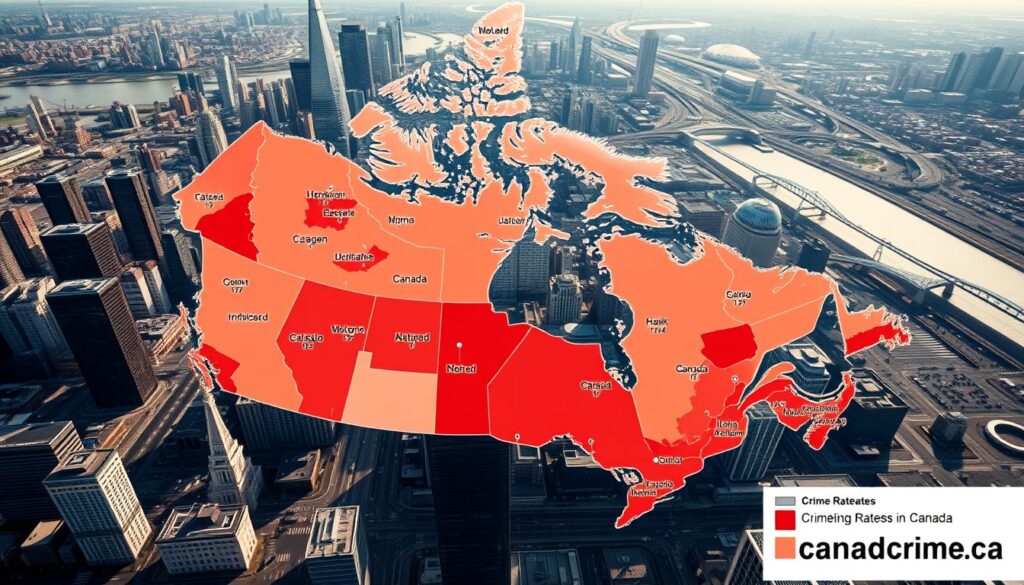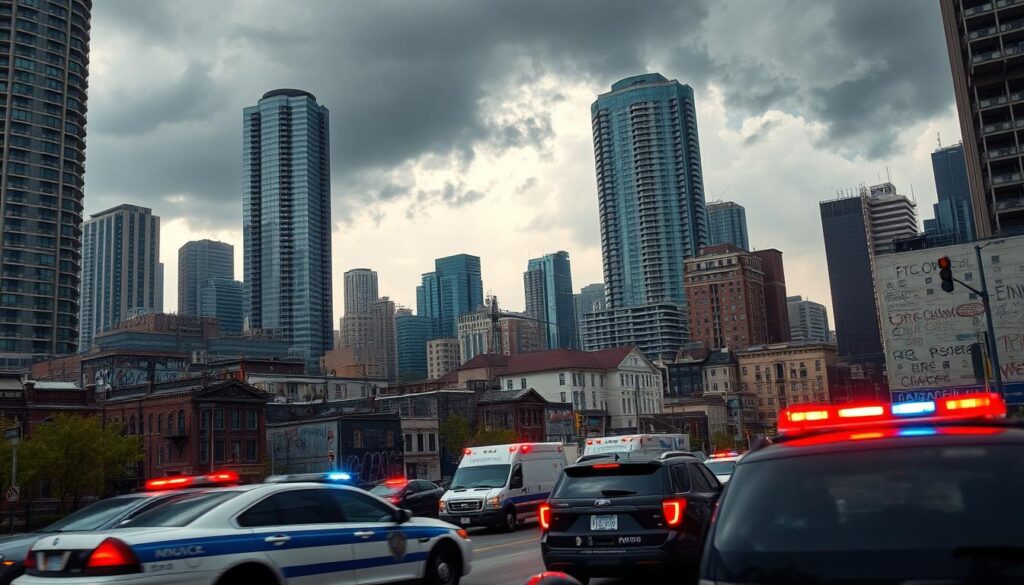Despite its reputation for safety, Canada faces crime challenges, with certain areas experiencing higher risks due to socioeconomic conditions, population density, and law enforcement effectiveness.
Red Deer, Alberta, has been identified as having the highest crime rate in Canada. The Crime Severity Index (CSI) is a key statistical measure used to track and address criminal activity across the country.
Understanding the factors that contribute to elevated crime rates is crucial. Socioeconomic conditions, population density, and local law enforcement play significant roles in shaping crime rates in Canadian communities.
Understanding Crime Rates in Canada
To grasp the scope of crime in Canada, it’s essential to examine the metrics used to measure criminal activity across different regions. Crime statistics in Canada are typically measured as rates per 100,000 people, creating a standardized metric that allows for fair comparisons between cities and regions with different population sizes.

Crime Severity Index Explained
The Crime Severity Index (CSI) is a statistical measure that takes into account both the frequency and severity of crimes reported to the police. It’s a valuable tool for understanding the relative seriousness of crime in different areas. According to a study on Canada’s crime rates, the CSI provides a more nuanced view of crime than simple crime rates, as it weights crimes based on their seriousness.
How Crime Statistics Are Measured
Crime statistics are compiled from police-reported incidents, with each criminal code violation documented and categorized according to protocols established by Statistics Canada. The data distinguishes between violent crimes (like homicide, assault, and sexual offenses) and non-violent crimes (including property crimes such as theft, breaking and entering, and fraud). Statistical reports also track clearance rates, providing insight into the effectiveness of law enforcement. By examining these statistics, communities can identify emerging trends and adapt their strategies to address changing patterns of criminal behavior.
Understanding crime rates and the CSI is crucial for developing effective crime prevention strategies. By analyzing crime data and trends, law enforcement and policymakers can work together to create safer communities across Canada.
The City with the Highest Crime Rate in Canada: Red Deer, Alberta
Red Deer, Alberta, stands out as the city with the highest crime rate in Canada, according to recent crime statistics. With a Crime Severity Index (CSI) of 176.4, Red Deer significantly exceeds larger Canadian cities like Winnipeg and Vancouver.

Crime Statistics and Trends in Red Deer
Red Deer’s crime statistics reveal a concerning trend. The city’s CSI is notably higher than that of other major Canadian cities. The crime rate is balanced between violent and property crimes, indicating a complex crime situation.
- The CSI of 176.4 highlights the severity of Red Deer’s crime challenges.
- Both violent and property crimes contribute to the high crime rate.
- Crime trends in Red Deer suggest a need for comprehensive crime prevention strategies.
Factors Contributing to Red Deer’s High Crime Rate
Several factors contribute to Red Deer’s high crime rate. Socio-economic conditions, such as unemployment and poverty, play a significant role. Additionally, the city’s demographic makeup and lack of resources may exacerbate the issue.
Key factors include:
- Economic challenges faced by the community.
- Demographic factors that may influence crime rates.
- Limited access to resources and services that could help mitigate crime.
Comparison with Other Major Canadian Cities
When compared to other major Canadian cities, Red Deer’s crime rate is notably higher. Cities like Toronto and Montreal have substantially lower crime rates, with CSI scores of 58.5 and 72.0, respectively.
Red Deer’s crime rate is more comparable to some mid-sized American cities, though still lower than the most crime-challenged U.S. urban areas. This comparison highlights the need for targeted crime prevention efforts in Red Deer.
Top 10 Canadian Cities with High Crime Rates
The crime rates in Canadian cities vary significantly, with some metropolitan areas facing more challenges than others. While overall Canada is considered safe, certain cities stand out due to their higher crime rates. This section will explore the top 10 Canadian cities with high crime rates, delving into the specifics of each city’s crime challenges.
Winnipeg: Highest Violent Crime Rate
Winnipeg tops the list with the highest violent crime rate among major Canadian cities. The city’s crime issues are multifaceted, involving a mix of violent and property crimes. According to local reports, factors such as socioeconomic conditions and lack of opportunities contribute to the high crime rate.
Thunder Bay: Comparable to American Cities
Thunder Bay has been noted for its crime rate, which is comparable to some American cities. The city faces challenges related to violent crime, with a rate that is significantly higher than many other Canadian cities. Efforts to address these issues include community programs aimed at reducing crime.
Saskatoon: Rising Homelessness and Crime
Saskatoon is another city experiencing a rise in crime, partly attributed to increasing homelessness. The city’s crime landscape includes both violent and property crimes, with a notable impact from the growing homeless population. Local initiatives focus on addressing the root causes of homelessness to mitigate its effect on crime.
Kelowna: Property Crime Capital
Kelowna is often cited as the property crime capital of Canada. The city sees a high rate of property crimes, including theft and vandalism. Factors contributing to this include the city’s growing population and the presence of transient individuals.
Edmonton and Regina: Prairie Provinces’ Crime Challenges
Both Edmonton and Regina face significant crime challenges. Edmonton, being one of Canada’s larger cities, experiences a wide range of crimes, from violent offenses to property crimes. Regina, similarly, deals with high rates of crime, particularly violent crime. The prairie provinces’ socioeconomic factors play a role in these cities’ crime rates.
Vancouver and Lower Mainland Cities
Vancouver, along with other Lower Mainland cities like Surrey and Burnaby, experiences a complex crime landscape. The region faces issues related to both violent and property crime, with a significant impact from drug-related offenses. The high cost of living and homelessness are also contributing factors.
Understanding the nuances of crime in these cities is crucial for developing effective crime prevention strategies. By examining the specific challenges faced by each city, policymakers and law enforcement can work towards creating safer communities.
| City | Crime Rate per 1,000 Residents | Major Crime Types |
|---|---|---|
| Winnipeg | 6.45 | Violent Crime |
| Thunder Bay | 6.23 | Violent Crime |
| Saskatoon | 5.92 | Property Crime, Violent Crime |
| Kelowna | 6.01 | Property Crime |
| Edmonton | 5.67 | Violent Crime, Property Crime |
| Regina | 5.45 | Violent Crime |
| Vancouver | 8.62 | Property Crime, Violent Crime |

“Crime prevention is a complex issue that requires a multifaceted approach, including community engagement, social programs, and effective law enforcement strategies.”
Preventing Crime in Canadian Communities
Cities with low crime rates in Canada offer valuable lessons for other communities looking to reduce their crime rates. Effective crime prevention requires a multi-faceted approach that addresses the root causes of criminal activity while enhancing enforcement capabilities.
Community policing initiatives have shown promising results in cities like Halton Region and Quebec City, which are among Canada’s safest urban areas. These initiatives foster relationships between law enforcement and residents, contributing to a lower average crime rate.
Other critical components of comprehensive crime prevention strategies include social programs targeting youth engagement, addiction treatment, and poverty reduction. Additionally, environmental design principles that incorporate proper lighting and natural surveillance opportunities can deter property crimes and reduce assault opportunities.
By examining the characteristics of Canada’s safest communities, primarily found in the greater Toronto and Montreal regions, common factors such as stable economic conditions, strong social cohesion, and strategic law enforcement approaches can be identified and adapted to higher-crime areas, ultimately reducing the overall crime rate across Canadian cities.

